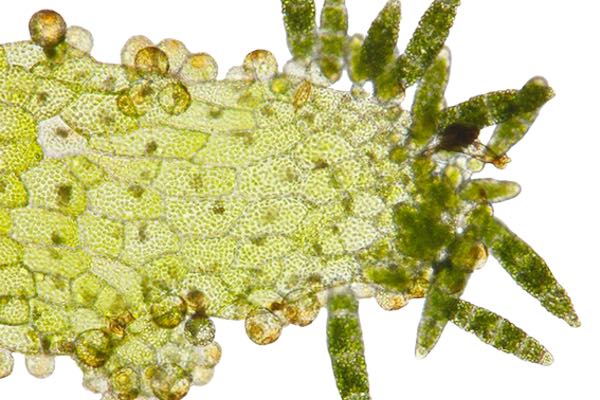A new special issue of Applications in Plant Sciences, “Methodologies in Gametophyte Biology,” highlights an often overlooked aspect of the botanical world. A collection of 15 articles describes techniques and approaches used in the study of gametophytes, the sexual portion of the plant life cycle that’s virtually unknown to everyone except botanists and naturalists. Despite their obscurity, gametophytes are vital to our understanding of biodiversity and to the successful implementation of conservation strategies.
There are more than 400,000 land plant species, which collectively form the basis of the terrestrial ecosystems and food webs that make life on land possible for animals.
Plants are distinct from animals, however, in reproducing with a two-step cycle called the “alternation of generations,” a trait they share with their algal ancestors. The great majority of plants encountered on a daily basis represent only half of this cycle, called the sporophyte generation. The gametophyte portion of the cycle is visible to only the most ardent observers, a pattern true of both lay people and botanists alike.
“The gametophyte generation has historically been ignored relative to its sporophyte counterpart for many land plant lineages,” said Sally Chambers, a research botanist at Marie Selby Botanical Gardens and one of the organizing editors of the special issue. “This is problematic, because to make sense of land plant evolution and modern distributions, it’s critical that we also take gametophytes into account.”
Topics in the special issue cover all major groups of land plants, encapsulating more than 470 million years of evolutionary innovation. During that span of time, the better-known sporophytes have gone from being small, short-lived stalks used only for producing spores to some of the largest (aspen colonies, giant sequoias) and oldest (bristlecone pines) organisms on earth, with nearly every conceivable variation of size and longevity in between.
Gametophytes have similarly diverged into a seemingly endless pageantry of forms, each of which presents a unique challenge to researchers attempting to unravel their secrets.
Gametophytes lack the vascular system of internal tubes possessed by most sporophytes, which transports water and nutrients from the most distant root tip to the highest leaf in the canopy. Without this vascular tissue, gametophytes are restricted in size, to the extent that a hand lens is most often needed to observe them in the field. They’re nearly invisible in seed plants, except in spring, when pollen coats every conceivable surface and plagues people with sensitive allergies. They’re most evident in ferns and lycophytes, where the two life stages exist separately from each other, and in other plants, like mosses, where the gametophyte is the leafy, dominant portion of the cycle that produces a small, short-lived sporophyte.
Even when viewed up close, however, the gametophytes of some closely related species can be nearly indistinguishable from one another based solely on size and shape.
“These are some of the most complicating factors for gametophyte biology,” Chambers said. “They can be morphologically cryptic, which makes field-based research difficult, and individually, they’re too small for most types of physiology equipment.”
Each of the 15 articles addresses issues and questions unique to the study of gametophytes and proposes novel ways in which this reserve of untapped diversity can be used to advance research in various fields of plant science.
Some of the techniques involve retrofitting equipment or applying strategies most commonly used for research in other systems. Such is the case for two papers (one by Farrar and Johnson and another by Rimgailė‐Voicik and Naujalis) on the detection and collection of subterranean gametophytes, which grow entirely underground and lack energy-producing chloroplasts. These gametophytes rely instead on symbiotic fungi for the sugar they need to grow. Chen et al. provide a protocol for extracting and sequencing these fungi from subterranean gametophytes, confirming for the first time the presence of fungal species commonly associated with plants growing in stressful environments.
Two articles (a review by Nitta and Chambers and an experimental investigation by Wu et al.) address the cryptic nature of lookalike gametophytes with easy and inexpensive DNA sequencing methods that can be used to quickly create a snapshot of gametophyte diversity in a given area.
The remaining articles run the gamut, from a study by Brennan et al. on volatile emissions in mosses, which have a similar function to the floral scents of flowering plants, to a study by Mitchell et al. on the high-speed video analysis of explosive spore and pollen dispersal.
The techniques outlined in this special issue help remove many of the barriers that have relegated gametophytes to the sidelines of scientific inquiry. According to Chambers, the only hurdle left to clear is encouraging more people to study them.
“I hope this special issue helps get people intrigued by the gametophyte generation and inspired to consider this life stage when conducting research,” she said. “These articles serve as a great resource for understanding past approaches and provide a blueprint for future advances.”
Read the special issue: Applications in Plant Sciences
Article source: Botanical Society of America via Eurekalert
Image: Microscopy image of a ribbon-shaped gametophyte of a vittarioid fern producing finger-like gemmae, with a sperm-releasing antheridium at the margin. Credit: Alexandria Quinlan. License: CC BY-NC-SA






